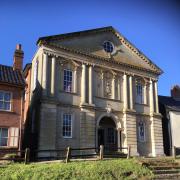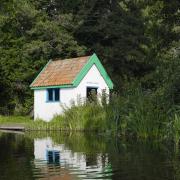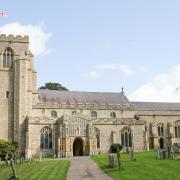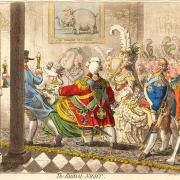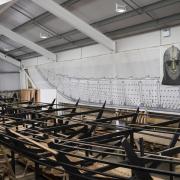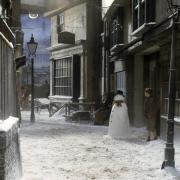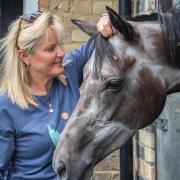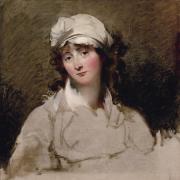New year... a time for setting goals and making resolutions. But while many of us will be promising to lose weight and spend more time in the gym, the villagers of Gazeley have a different sort of target in their sights – raising the £100,000 needed (fairly urgently) to repair the roof of their ancient church and thereby save its unique ceiling.
Is there another church anywhere that can boast a ceiling comprising 120 carved bosses, all different, depicting everything from mythical beasts, religious icons, people, sciapods, wild and domestic animals, plants, angels... and a man baring his buttocks to the world? The answer is no; this extraordinary piece of medieval art belongs only to All Saints Church.
The church was already 200 years old when its wagon roof was installed. There are other churches with these huge barrel-vaulted constructions, some with elaborately carved beams and bosses, but none feature such a rich variety of subject matter as those at All Saints. Believed to have been carved between 1500 and 1520 – judging by the clothes depicted on the various figures – the ceiling is a quirky commentary on the concerns, beliefs, passions and preoccupations of late medieval life.

The carvings were almost certainly paid for by the Earl of Stafford, third Duke of Buckingham and Lord of the Manor, whose coat of arms and badges are scattered throughout. They were perilous times for the church and nobility and, sadly, Stafford lost his head in 1521, found guilty of High Treason. But the ceiling survived; first the ravages of Henry VIII's Reformation, then a century later General William 'Smasher' Dowsing, Oliver Cromwell's Laxfield-born 'commissioner for the destruction of monuments of idolatry and superstition'.
The carvings would have been well within his remit, but in the 17th century churches were poorly lit and the nature of the carvings probably went unnoticed. Anyway, how was anyone to get up there without scaffolding?
Six hundred years later, the greatest threat to their continued existence is the English weather and All Saints' leaky outer chancel roof that covers the carvings. The old hand-made terracotta tiles need to be replaced, work that will cost more than £100,000.

Some of the money may come from charitable trusts, such as Suffolk Historic Churches Trust, but as All Saints' vicar Rev Chris Childs and churchwarden Simon Gash explain, that sort of funding will most likely be conditional on the parish raising at least half the total amount required. With costs rising, the estimate is now closer to £140,000, which means raising £70,000 locally just to apply for grant aid.
It's not the first time All Saints has needed to be rescued. Back in 2005 the building was in a sorry state of disrepair when Gazeley resident Jack Marsh died, leaving £30,000 for its restoration and renovation. Thanks to Jack's generosity, work got underway between 2008 and 2009, revealing some surprising and important features of the lovely old church.
There were colourful medieval wall paintings that had been covered up to avoid destruction at the hands of the iconoclasts. Fragments are now visible. But it was the carvings, visible up close for the first time from the scaffolding erected under the chancel's wagon roof, that caused a stir among parishioners. Maggie Pugh, then church warden, was among those who climbed the scaffolding, taking her camera with her.

Excited by her find, Maggie put some of her photos in frames – including the bared bum carving – and displayed them on the information table in the church. Some time later, 'Pants Down Paddy' grabbed the attention of historian, medieval church enthusiast and photographer Simon Johnson, a Yorkshireman living in New Zealand. In 2018, on one of his regular trips to East Anglia, he visited All Saints and pointed his telephoto lens at the chancel ceiling in search of the little knave. Seeing the tiles in all their detail, he couldn't believe what he was looking at. Why, he wanted to know, was this ceiling not known the world over? Why, indeed?
In 2020, Simon sent his entire collection of photos to Maggie, as a thank you for the warm welcome the church gives visitors. She put them together in an exhibition which is still in the church. A year later the first edition of Simon's book about the ceiling, Men, Myths and Monsters, was published. It's now in its third edition, with all proceeds from its sale going to the restoration fund.
The importance of the carvings can't be overestimated and several leading academics and specialists have given their support to the appeal. They include Clive Paine, vice-president of the Suffolk Historic Churches Trust, Suffolk Institute of Archaeology and History and Suffolk Records Society; Prof Sarah Peverley of Liverpool University who works in the field of medieval history and culture; and the remarkable Simon Knott, author and creator of suffolkchurches.co.uk, who over the last 30 years has visited, recorded and photographed more than 2,000 of East Anglia's churches.

They all recognise the carvings as ‘unique and of national importance’; Sarah Peverley believes they make a major contribution to late medieval art and must be preserved. As Simon Knott says in his video on the All Saints Church website, once gone, they can't be remade.
Gazing up at the carvings, I felt that same crick in my neck I had from standing too long looking at that other, much more famous ceiling in Rome. This one might be much less flamboyant than Michelangelo's Sistine Chapel decoration, but in its own modest way, it's no less important. A Suffolk – and a national – treasure.
To find out more about All Saints Church, Gazeley, and the roof appeal go to gazeleychurch.org/save-our-ceiling
For a copy of Men, Myths and Monsters by Simon Johnson email lazarusnfp@btinternet.com. All proceeds to the
















